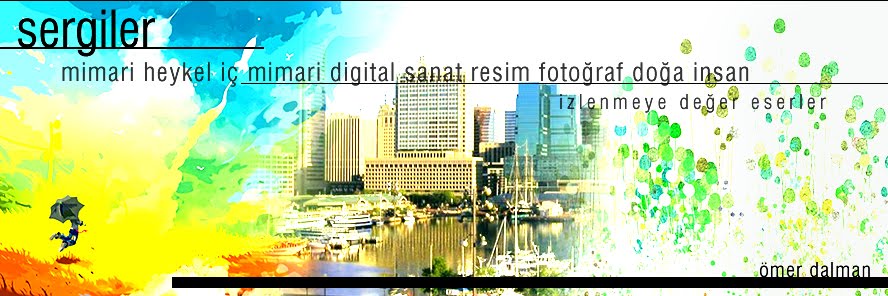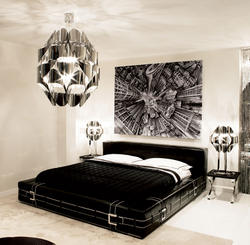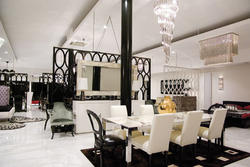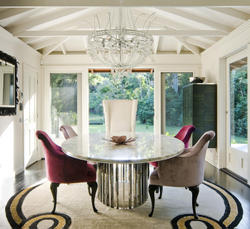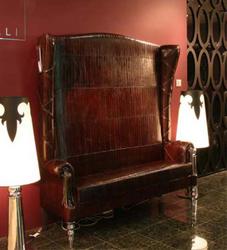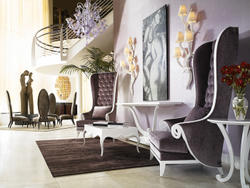22 Ağustos 2013 Perşembe
18 Ağustos 2013 Pazar
Psychiko House
- work finished in 2012
- type Single-family residence
The 600m2 private residence is located in Psychiko, a hilly low density suburb of Athens, on a 1000m2 gently sloping site offering commanding views to the cityscape below.
The house is divided into three distinct zones. A chthonic core clad in grey stone and inspired by the imagery of the quarries of the Attica landscape houses the gallery for the owners’ collection of vintage cars and modern art. An amphitheatrical upper floor, conceived as a pair of binoculars kinking to frame city views, encompasses the private areas of the residence while a transparent and fluid living area occupies the space between them.
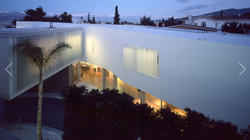


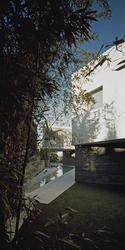

These elements are strung together through a notional ribbon that circulates through the site and defines the spatial narrative, revealing views along its path. This ribbon introduces you to the house through a compressed curving view which cuts through the stone wall that shelters the residence from the surrounding buildings to the south. It then opens to a view towards the intimate pool garden, that offers an opportunity for a shared space with the neighbouring house. Finally, as it becomes wider, it turns to form the living spaces of the residence which offer a dramatic expansive view to the Olympic Park below. The effect is like standing on the edge of a diving board ready to plunge into the cityscape.
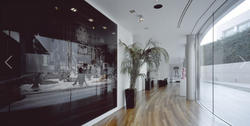

As the opaque, linear, stone-clad boundary wall to the south peels away to create the outdoor pool space the sweeping move of the external wall is echoed by the swimming pool, a canal that connects the front and back of the house. Glazed partitions, skylights, and slatted blinds allow natural light to penetrate the living spaces and a series of cuts and slits in the sculptural façade bring the outside in. The house is conceived and experienced as a series of surprises playing with light and scale while the design exploits the tension between conflicting elements – opaqueness and transparency, intimacy and openness, curves juxtaposed with angular geometry.


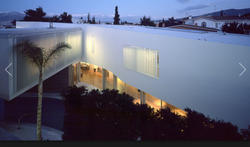
Etiketler:
modern architecture,
modern ev,
modern house,
modern interior,
modern mimari
13 Ağustos 2013 Salı
feel the rainbow!
Artist Gabriel Dawe is showing his incredible new installation that just opened to the public last October 6 in Como, Italy. As part of Miniartextil, an annual exhibition of contemporary art, Dawe created Plexus no. 19, a stunning thread installation that’s beautifully spread across two balconies in the atrium of a historic villa. The early 19th century neoclassic house, called Villa Olmo, was acquired in 1924 by the municipality of Como and is now open to the public only during cultural events and art exhibitions like this.
This year’s Miniartextil exhibition is called Agora, taking from the Greek word that describes an important public place where people come to share ideas. The visitor is invited to not just look at the artwork but to be actively involved in it.Plexus no. 19 consists of two thread structures streamed across Artist Gabriel Dawe is showing his incredible new installation that just opened to the public last October 6 in Como, Italy. As part of Miniartextil, an annual exhibition of contemporary art, Dawe created Plexus no. 19, a stunning thread installation that’s beautifully spread across two balconies in the atrium of a historic villa. The early 19th century neoclassic house, called Villa Olmo, was acquired in 1924 by the municipality of Como and is now open to the public only during cultural events and art exhibitions like this.
This year’s Miniartextil exhibition is called Agora, taking from the Greek word that describes an important public place where people come to share ideas. The visitor is invited to not just look at the artwork but to be actively involved in it.Plexus no. 19 consists of two thread structures streamed across an upper and lower balcony that is meant to be experienced from different angles or at different times of the day. As Dawe tells us, “When the sun comes in in the morning, it is fantastic. Having those window-shaped light beams add a dimension to the installation. I always like when I get direct sunshine on them because it emphasizes the layering of the thread in very interesting ways.”
With two assistants, Dawe constructed this installation in about a week. His greatest challenge was working to the confines of the space. “Because of the historic nature of the building, I wasn’t able to touch ceiling, walls or floors to screw in my structures,” he says. “So I resorted to fixing them to the railings, which in great measure restricted what I was able to do. In the end, it worked out pretty well; it really exceeded my expectations how well the installation inhabits the space.”
This year’s Miniartextil exhibition is called Agora, taking from the Greek word that describes an important public place where people come to share ideas. The visitor is invited to not just look at the artwork but to be actively involved in it.Plexus no. 19 consists of two thread structures streamed across Artist Gabriel Dawe is showing his incredible new installation that just opened to the public last October 6 in Como, Italy. As part of Miniartextil, an annual exhibition of contemporary art, Dawe created Plexus no. 19, a stunning thread installation that’s beautifully spread across two balconies in the atrium of a historic villa. The early 19th century neoclassic house, called Villa Olmo, was acquired in 1924 by the municipality of Como and is now open to the public only during cultural events and art exhibitions like this.
This year’s Miniartextil exhibition is called Agora, taking from the Greek word that describes an important public place where people come to share ideas. The visitor is invited to not just look at the artwork but to be actively involved in it.Plexus no. 19 consists of two thread structures streamed across an upper and lower balcony that is meant to be experienced from different angles or at different times of the day. As Dawe tells us, “When the sun comes in in the morning, it is fantastic. Having those window-shaped light beams add a dimension to the installation. I always like when I get direct sunshine on them because it emphasizes the layering of the thread in very interesting ways.”
With two assistants, Dawe constructed this installation in about a week. His greatest challenge was working to the confines of the space. “Because of the historic nature of the building, I wasn’t able to touch ceiling, walls or floors to screw in my structures,” he says. “So I resorted to fixing them to the railings, which in great measure restricted what I was able to do. In the end, it worked out pretty well; it really exceeded my expectations how well the installation inhabits the space.”
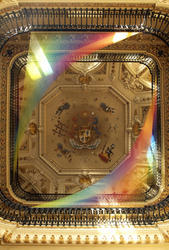





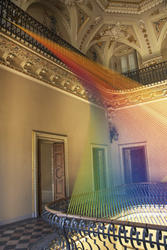



Etiketler:
classic architecture,
classic interior,
iç dekorasyon,
iç mimari,
klasik mimari
Kaydol:
Kayıtlar (Atom)
